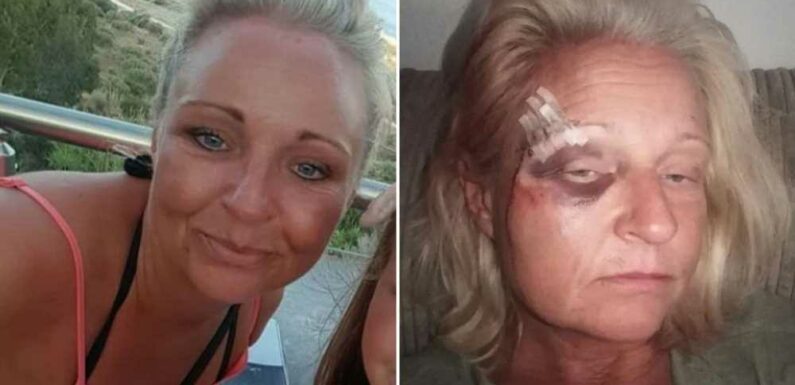
A MUM of five lost half her face to a flesh eating disease and nearly died following a minor fall.
But she credits her grisly ordeal to finding the love of her life.
When Donna Corden, 51, slipped and banged her head on her oven in January 2017, she didn't think much of the resulting half-inch cut on her browbone.
"It was tiny," the single mum from Leeds told the Daily Star.
But she grew worried when her face started swelling the next day.
"My eye had started going black, but nowhere near where the cut was," she recalled.
Read more on flesh eating diseases
I looked like a zombie after disease ate my face – don’t make my mistake
I’ve had skin on my testicles removed after flesh-eating bug nearly killed me
Then she started getting black blisters around her eye socket and underneath her eye.
Her daughter Jayde Stammers, 31, called 999 after watching Donna get increasingly unwell.
The mum-of-five was rushed to hospital.
At St James Hospital in Leeds, doctors were able to put a name to Donna's frightening symptoms – they said she was infected with necrotising fasciitis.
Most read in Health
I’m a sleep expert – here’s the exact amount of kip you need to get at each age
I'm a nutritionist – the 6 warning signs that you need to cut back on sugar
Exact time you need to fall asleep to avoid raising risk of dementia
Urgent warning to parents about death risk of co-sleeping with babies
The rare and potentially lethal bacteria was eating away at her face and terrifyingly making its way to her brain.
It was dissolving her flesh at a rate of three centimetres an hour, Donna said.
"I had life-saving surgery where they literally had to remove half of my face. They were working against the clock," Donna said.
Doctors doubted whether she would be able to pull through and warned her kids to prepare for the worst.
The mum-of-five survived the surgery but suffered sepsis and kidney failure, slipping into a four-day coma.
She remained on life support for several weeks after waking up.
Afterwards, Donna had skin cut from her thigh and transplanted onto her face in a gruelling 11-hour surgery.Another 15 or 16 surgeries followed.
Donna is now waiting to have a procedure that will lift up her mouth on one side.
She'll also have the skin graft on her face tattooed so the colour matches the rest of her face.
She hopes these will be the last treatments she'll have to undergo.
Following the horrific ordeal, Donna confessed her hopes of meeting someone were very low.
But meet someone she did – and they're getting married.
Donna's fiancé, James Olsen, reached out to her on Facebook following her injury.
An 'old, old friend' who was at preschool with her, wished Donna well and asked if she was free to talk.
Donna said she messaged him straight back. They got to chatting and arranged to meet for a drive.
"We've been together ever since," she said.
The pair plan to tie the knot in Cyprus in June next year.
What is necrotising fasciitis?
The NHS explains necrotising fasciitis is a flesh-eating disease.
Guidance states it’s a very rare condition that can happen if a wound gets infected – it needs to be treated in hospital straight away.
The first signs of the illness are:
- Intense pain or loss of feeling near to a cut or wound – the pain may seem much worse than you would usually expect from a cut or wound
- Swelling of the skin around the affected area
- Flu-like symptoms, such as a high temperature, headache and tiredness
Later symptoms may include:
- Being sick (vomiting) and diarrhoea
- Confusion
- Black, purple or grey blotches and blisters on the skin (these may be less obvious on black or brown skin)
You should go to A&E if you have a cut that is more painful than expected.
The NHS states you also need emergency care if you have a cut or wound and get symptoms like a high temperature, headache, tiredness and muscle aches.
If you have sudden confusion or if you have black, purple or grey blotches or blisters near a cut or wound, go to A&E or call 999.
Necrotising fasciitis gets worse quickly and can be fatal, so it must be treated in hospital as soon as possible.
Treatment will usually include:
- antibiotics
- surgery to remove the affected area
Read More on The Sun
I did weekly shop at M&S and found 14 items cheaper or same price as Aldi & Lidl
I transformed my council house kitchen with cheap buys from Wilko & B&M…it’s so posh
NHS guidance notes there may be long-term changes in how your body looks and how you move or use the affected part of your body, even after successful treatment.
Sometimes the affected limbs might need to be amputated, and you may need further surgery and physiotherapy to help you recover.
Source: Read Full Article











